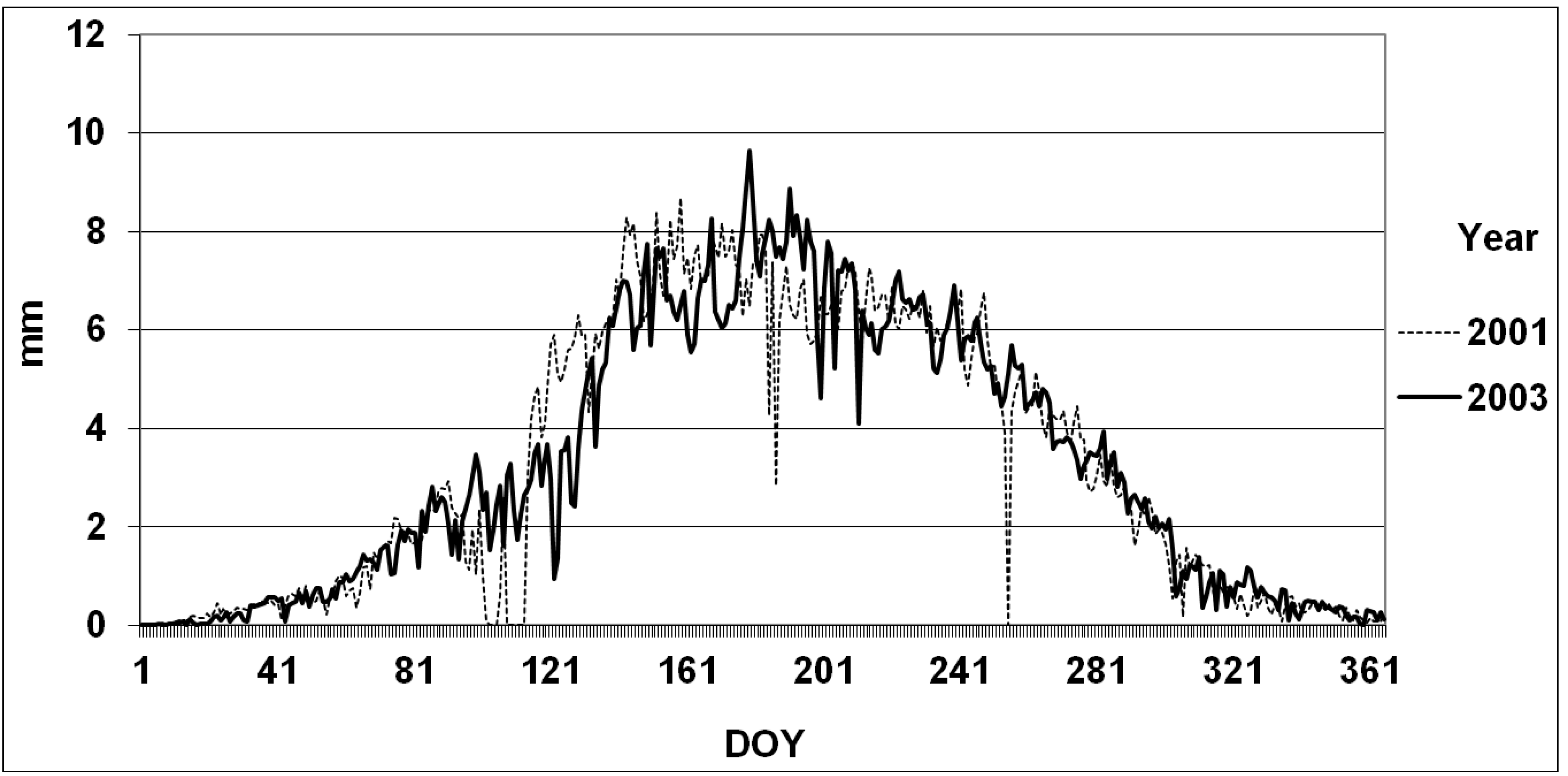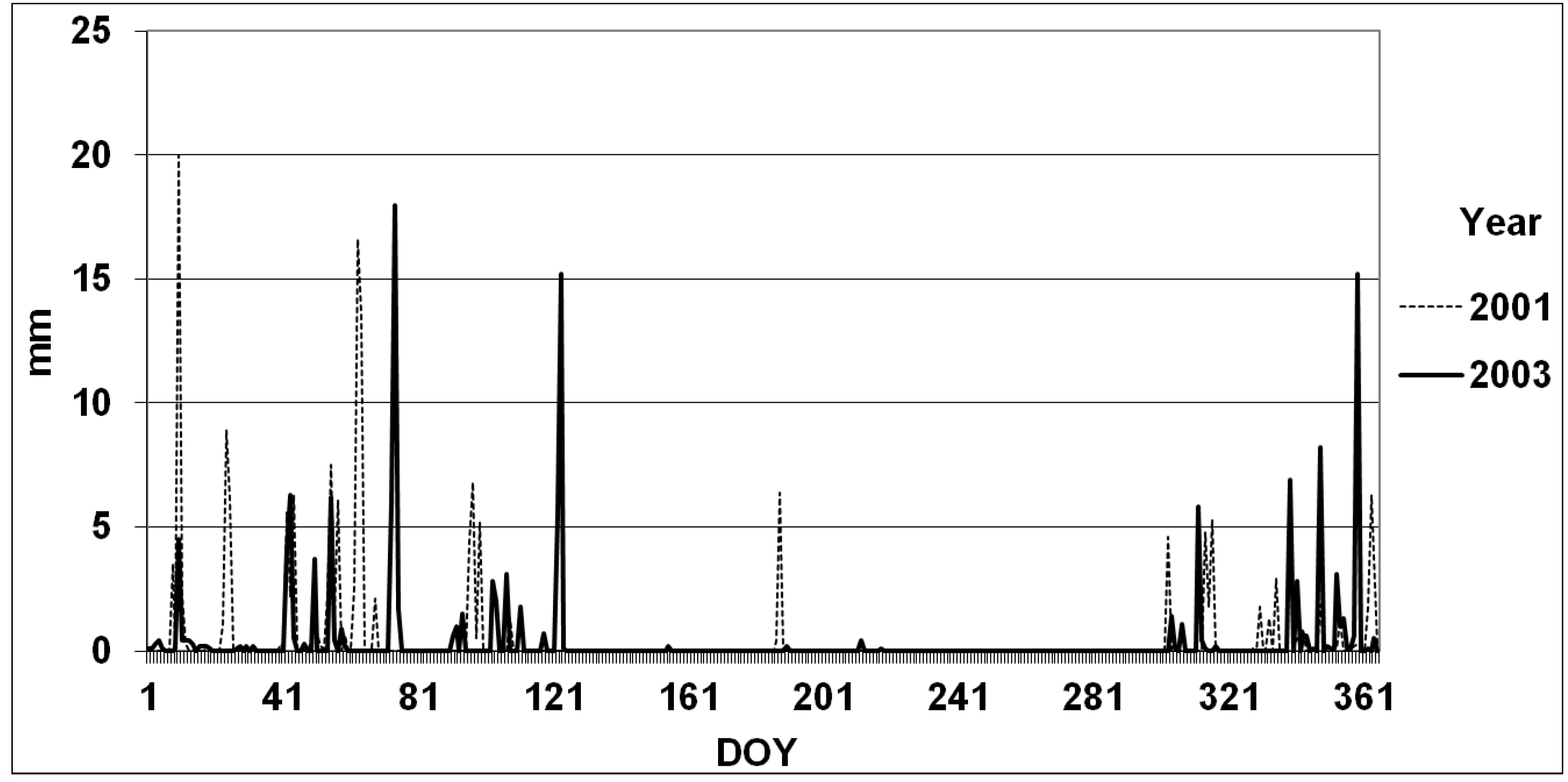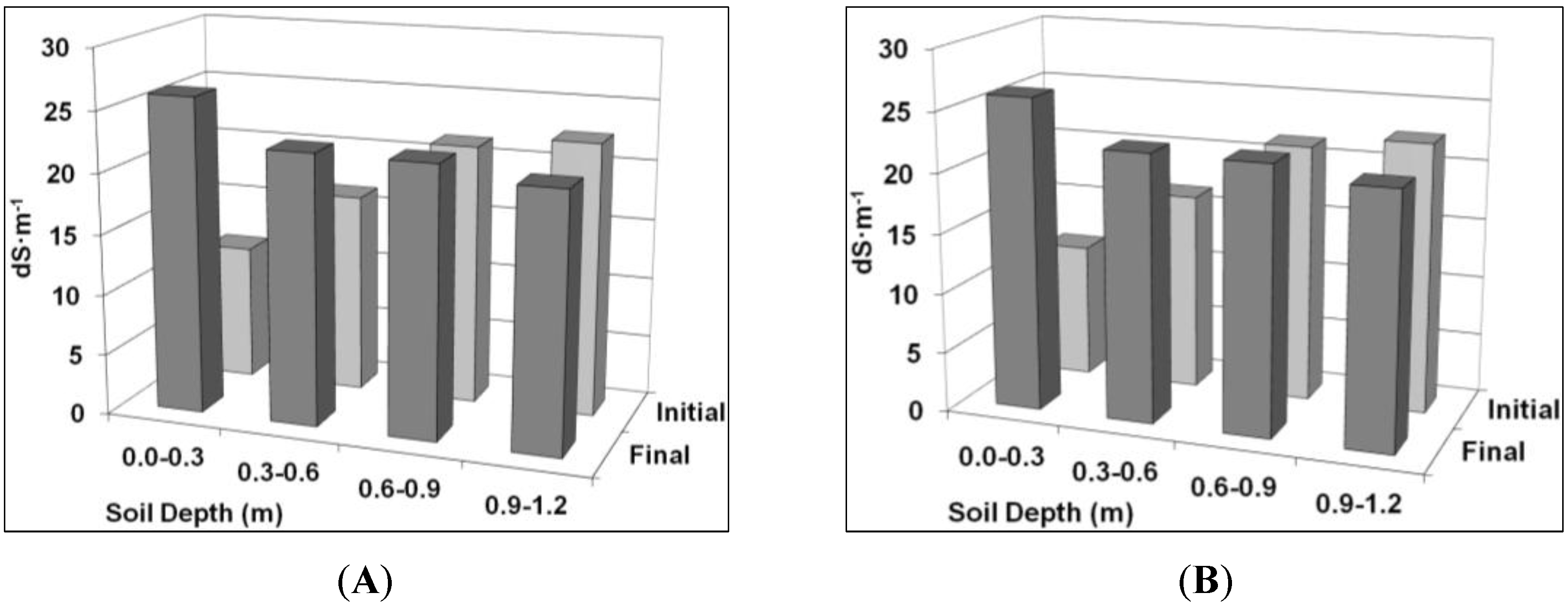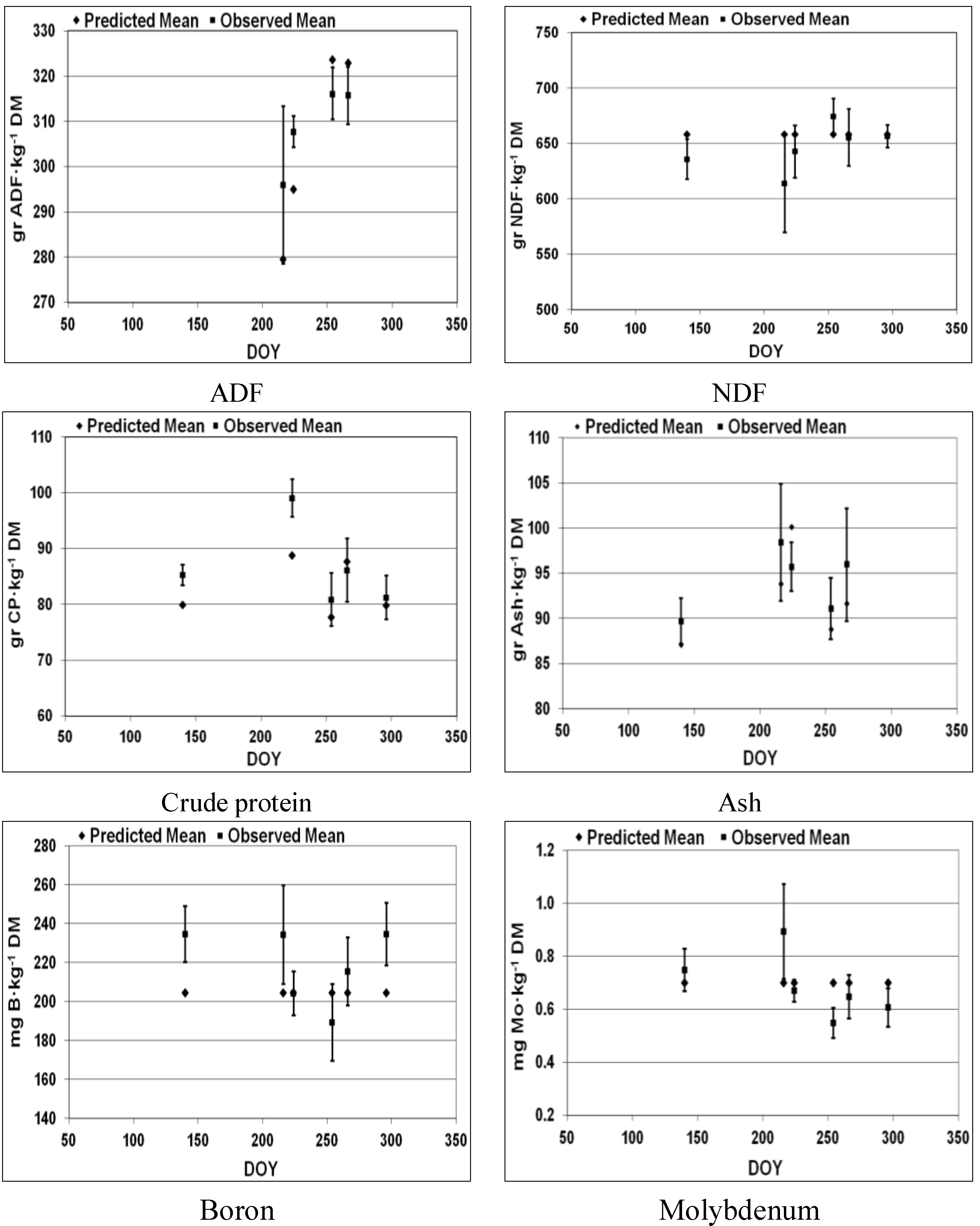Modeling a Sustainable Salt Tolerant Grass-Livestock Production System under Saline Conditions in the Western San Joaquin Valley of California
Abstract
:1. Introduction
2. Experimental Section
2.1. Model Formulation and Parameterization
| Month | Kc | Month | Kc |
|---|---|---|---|
| January | - | July | 1.06 |
| February | - | August | 0.96 |
| March | 0.67 | September | 0.78 |
| April | 0.84 | October | 0.64 |
| May | 0.97 | November | 0.54 |
| June | 1.06 | December | - |
- (1)
- (t) = Time t
- (2)
- ETc = Crop evapotranspiration (L·ha−1 day)
- (3)
- ETo = Potential evapotranspiration (L·ha−1 day)
- (4)
- Kc = Crop coefficient
- (1)
- (t) = Time t
- (2)
- SM = Soil moisture(L·ha−1)
- (3)
- PP = Rainfall (L·ha−1·day)
- (4)
- IW = Irrigation water (L·ha−1·day)
- (5)
- ETc = Crop evapotranspiration (L·ha−1·day)
- (6)
- DW = Drainage and runoff water (L·ha−1·day)
- (7)
- LF = Leaching fraction (L·ha−1·day)
- (1)
- (t) = Time t
- (2)
- TDS_S (t) = Total dissolved solids (TDS) in the soil (gr)
- (3)
- TDS_IW (t) = TDS in the irrigation water (gr)
- (4)
- TDS_PU (t) = TDS in the plant uptake (gr)
- (5)
- TDS_DW (t) = TDS in the drainage and runoff water (gr)
- (6)
- TDS_LF (t) = TDS in the leaching fraction (gr)
- (7)
- Fmax (t) = Maximum plant uptake rate of TDS (mg·L −1·day)
- (1)
- B_S (t) = Boron in the soil (gr)
- (2)
- B_IW (t) = Boron in the irrigation water (gr)
- (3)
- B_PU (t) = Plant uptake of boron (gr)
- (4)
- B_DW (t) = Boron in the drainage and runoff water (gr)
- (5)
- B_LF (t) = Boron in the leaching fraction (gr)
- (6)
- B_PT (t) = Boron in the plant tissues (ppm)
- (7)
- Se_S (t) = Selenium in the soil (gr)
- (8)
- Se_IW (t) = Selenium in the irrigation water (gr)
- (9)
- Se_PU (t) = Plant uptake of selenium (gr)
- (10)
- Se_DW (t) = Selenium in the drainage and runoff water (gr)
- (11)
- Se_LF (t) = Selenium in the leaching fraction (gr)
- (12)
- Se_PT(t) = Selenium in the plant tissues (ppm)
- (13)
- Mo_S (t) = Molybdenum in the soil (gr)
- (14)
- Mo_IW (t) = Molybdenum in the irrigation water (gr)
- (15)
- Mo_PU (t) = Plant uptake of molybdenum (gr)
- (16)
- Mo_DW (t) = Molybdenum in the drainage and runoff water (gr)
- (17)
- Mo_LF (t) = Molybdenum in the leaching fraction (gr)
- (18)
- Mo_PT (t) = Molybdenum in plant tissues (ppm)
- (1)
- Yield (t) = Total yield (kg·ha−1)
- (2)
- Growth (t) = Plant growth (kg·ha−1·day)
- (3)
- Harvest (t) = Fraction of the total yield harvested (kg·ha−1)
- (1)
- RME_TOT (t) = Total requirement of metabolic energy (Mj)
- (2)
- MEm (t) = Requirement of metabolic energy for maintenance (Mj)
- (3)
- MEwg (t) = Requirement of metabolic energy for weight gain (Mj)
- (4)
- Weight (t) = Live weight (kg)
- (5)
- Km (t) = Maintenance efficiency (%)
- (6)
- Kwg (t) = Weight gain efficiency (%)
- (7)
- ADG (t) = Average daily gain of weight (kg·day−1)
- (8)
- RDM_TOT (t) = Total requirement of dry matter (kg)
- (9)
- CC (t) = Caloric concentration of the pasture (Mj)
- (10)
- H (t) = Harvest coefficient (%)
- (11)
- Cumulative_Intake (t) = DM intake of an AU (kg)
- (12)
- Km (t) = 0.55 + 0.016 × CC
- (13)
- Kwg (t) = 0.0435 × CC
2.2. Model Validation
2.2.1. ETc and Soil Water Dynamics


| Year | IW (m3·ha−1) | Eciw (dS·m−1) | Year | IW (m3·ha−1) | ECiw (dS·m−1) |
|---|---|---|---|---|---|
| 2001 | 2003 | ||||
| 5-Jun-01 | 1,464 | 8.7 | 12-Apr | 897 | 3.2 |
| 18-Jul-01 | 1,086 | 14.4 | 23-May | 1,045 | 4.9 |
| 2-Aug-01 | 768 | 11.5 | 21-Jun | 655 | 1.5 |
| 24-Aug-01 | 1,091 | 16.2 | 3-Jul | 774 | 2.9 |
| 14-Sep-01 | 854 | NM | 26-Jul | 1,026 | 4.3 |
| 28-Sep-01 | 583 | NM | 14-Aug | 1,039 | 0.8 |
| --- | --- | --- | 26-Aug | 191 | 2.4 |
| --- | --- | --- | 4-Sep | 721 | 2.0 |
| --- | --- | --- | 3-Oct | 1,364 | 1.7 |

2.2.2 Soil Salinity Dynamics

2.2.3. Soil Trace Minerals Dynamics
| Year | B (mg·L−1) | Se (µg·L−1) | Mo (µg·L−1) |
|---|---|---|---|
| 2001 | 15.1 | 700 | 400 |
| 2003 | 2 | 30 | 160 |
| 1999 | 2004 | |||||||
|---|---|---|---|---|---|---|---|---|
| Mean | Min | Max | SD | Mean | Min | Max | SD | |
| B (mg·L−1) | 17.9 | 1.1 | 42.5 | 6.2 | 14.1 | 1.3 | 37.2 | 7.0 |
| Se (μg·L−1) | 12.5 | 0.0 | 77.0 | 11.1 | 71.3 | 0.0 | 704.0 | 132.8 |
| Mo (μg·L−1) | 835.1 | 180.0 | 3,043.0 | 438.1 | 371.8 | 0.0 | 2,484.0 | 368.8 |
2.2.4. Forage Yield

2.2.5. Forage Quality

| K gr·kg−1 DM | Ca gr·kg−1 DM | Mg gr·kg−1 DM | Se µg·kg−1 DM | ||||||
|---|---|---|---|---|---|---|---|---|---|
| Year | 2001 | 2001 | 2001 | 2001 | 2001 | 2001 | 2001 | 2001 | 2001 |
| Day of the year | 171 | 297 | 171 | 297 | 171 | 297 | 171 | 250 | 297 |
| Predicted Mean | 1.90 | 1.90 | 0.47 | 0.47 | 0.26 | 0.26 | 70.30 | 70.30 | 70.30 |
| Observed Mean | 2.14 | 1.55 | 0.58 | 0.51 | 0.26 | 0.15 | 75.68 | 91.61 | 74.53 |
| Std. Dev. Obs Mean | 0.17 | 0.24 | 0.07 | 0.04 | 0.02 | 0.02 | 22.48 | 28.51 | 23.93 |
| Upper 95% Obs Mean | 2.22 | 1.67 | 0.61 | 0.53 | 0.27 | 0.16 | 81.34 | 101.26 | 80.15 |
| Lower 95% Obs Mean | 2.06 | 1.44 | 0.55 | 0.49 | 0.25 | 0.14 | 70.02 | 81.96 | 68.91 |
| Observations | 20 | 20 | 20 | 20 | 20 | 20 | 63 | 36 | 72 |
2.2.6. Stocking Rate and Average Daily Gain
| Year | Gazing Period | Treatment | Steers | Stocking Rate | ADG | SD |
|---|---|---|---|---|---|---|
| Days | # | AU·ha−1 | kg·day−1 | kg·day−1 | ||
| 2001 | 143 | Control* | 8 | 0.5 | 0.56 | 0.09 |
| 143 | Treatment | 18 | 0.5 | 0.46 | 0.23 | |
| 2003 | 150 | Control | 10 | 0.6 | 0.55 | 0.15 |
| 150 | Treatment | 30 | 0.9 | 0.72 | 0.12 |
3. Results and Discussion
3.1. Irrigation Management
3.2. Fertilization Management
3.3. Grazing Management
3.4. System Performance
4. Conclusions
Acknowledgements
Conflicts of Interest
References
- Swain, W.C. Estimation of Shallow Ground-Water Quality in the Western and Southern San Joaquin Valley, California; San Joaquin Valley Drainage Program: Sacramento, CA, USA, 1990. [Google Scholar]
- Wichelns, D.; Oster, J.D. Sustainable irrigation is necessary and achievable, but direct costs and environmental impacts can be substantial. Agr. Water Manage. 2006, 86, 114–127. [Google Scholar] [CrossRef]
- Tanji, K.K.; Lauchli, A.; Meyer, J. Selenium in the San Joaquin Valley. Environment 1986, 28, 6–11. [Google Scholar] [CrossRef]
- San Joaquin Valley Drainage Program, A Management Plan for Agricultural Subsurface Drainage and Related Problems on the Westside San Joaquin Valley; San Joaquin Valley Drainage Program: Sacramento, CA, USA, 1990.
- National Research Council, Soil and Water Quality: An Agenda for Agriculture: Committee on Long-Range Soil and Water Conservation, Board on Agriculture; The National Academies Press: Washington, DC, USA, 1993; p. 516.
- Shani, U.; Hanks, R.J. Model of integrated effects of boron, inert salt and water flow on crop yield. Agron. J. 1993, 85, 713–717. [Google Scholar] [CrossRef]
- Deverel, S.J.; Gilliom, R.J.; Fujii, R.; Izbicki, J.A.; Fields, J.C. Aerial distribution of selenium and other inorganic constituents in shallow ground water of the San Luis Drain Service Area, San Joaquin Valley, California: A preliminary study. Available online: http://pubs.usgs.gov/wri/1984/4319/report.pdf (accessed on 23 June 2013).
- Deverel, S.J.; Fujii, R. Processes affecting the distribution of selenium in shallow ground water of agricultural areas, western San Joaquin Valley, California. Water Resour. Res. 1988, 24, 516–524. [Google Scholar] [CrossRef]
- Deverel, S.J.; Millard, S.P. Distribution and mobility of selenium and other trace elements in shallow ground water of the western San Joaquin Valley, California. Environ. Sci. Technol. 1988, 22, 697–702. [Google Scholar] [CrossRef]
- Fujii, R.; Deverel, S.J. Mobility and distribution of selenium and salinity in groundwater and soil drained agricultural fields, Western San Joaquin Valley of California. In Selenium in Agriculture and Environment; Jacobs, L.W., Ed.; SSSA Special Publication: Madison, WI, USA, 1989; pp. 195–212. [Google Scholar]
- Van Schilfgaarde, J. Irrigation agriculture: Is it sustainable? In Agricultural Salinity Assessment and Management, ASCE Manu Report Practices; Tanji, K.K., Ed.; ASCE: Reston, VA, USA, 1990; pp. 584–594. [Google Scholar]
- Suttle, N.F. The interactions between copper, molybdenum, and sulphur in ruminant nutrition. Annu. Rev. Nutr. 1991, 4, 121–140. [Google Scholar] [CrossRef]
- Fujii, R.; Swain, W.C. Aerial distribution of selected trace elements, salinity, and major ions in shallow ground water, Tulare Basin, Southern San Joaquin Valley, California. Available online: http://wwwrcamnl.wr.usgs.gov/Selenium/Library_articles/FujiiSwain_text.pdf (accessed on 23 June 2013).
- Oster, J.D.; Grattan, S.R. Drainage water reuse. Irrigation Water Syst. 2002, 16, 297–310. [Google Scholar] [CrossRef]
- Schoups, G.; Hopmans, J.W.; Young, C.A.; Vrugt, J.A.; Wallender, W.W.; Tanji, K.K.; Panday, S. Sustainability of irrigated agriculture in the San Joaqin Valley, California. Proc. Natl. Acad. Sci. USA 2005, 102, 15352–15356. [Google Scholar]
- ANON. Grasslands Drainage Program. Available online: http://www-esd.lbl.gov/quinn/Grassland_Bypass/grasslnd.html (accessed on 23 June 2013).
- Skorupa, J.P. Selenium poisoning of fish and wildlife in nature: Lessons from twelve real-world examples. In Environmental Chemistry of Selenium; Frankenberger, W.T., Engberg, R.A., Eds.; Taylor & Francis: Abingdon, UK, 1998; pp. 315–334. [Google Scholar]
- Corwin, D.; Kaffka, S.R.; Oster, J.D.; Hopmans, J.W.; Mori, Y.; van Groenigen, J.-W.; van Kessel, C. Assessment and field-scale mapping of soil quality properties of a saline-sodic soil. Geoderma 2003, 114, 231–259. [Google Scholar] [CrossRef]
- Kaffka, S.R.; Oster, J.D.; Corwin, D.L. Forage production and soil reclamation using saline drainage water. In Proceedings of the National Alfalfa Symposium, San Diego, CA, USA, 13–15 December 2004; pp. 247–253.
- Robinson, P.H.; Grattan, S.R.; Getachew, G.; Grieve, C.M.; Poss, J.A.; Suarez, D.L.; Benes, S.E. Biomass accumulation and potential nutritive value of some forages irrigated with saline-sodic drainage. Anim. Feed Sci. Tech. 2004, 111, 175–189. [Google Scholar] [CrossRef]
- Grattan, S.R.; Grieve, C.M.; Poss, J.A.; Robinson, P.H.; Suarez, D.L.; Benes, S.E. Reuse of saline-sodic drainage water for irrigation in California: Evaluation of potential forages. In Proceedings of the 17th World Congress on Soil Salinity, Bangkok, Thailand, 14–21 August 2002; pp. 110–120.
- Grattan, S.R.; Grieve, C.M.; Poss, J.A.; Robinson, P.H.; Suarez, D.L.; Benes, S.E. Evaluation of salt-tolerant forages or sequential water reuse systems, I. Biomass production. Agr. Water Manage. 2004, 70, 109–120. [Google Scholar] [CrossRef]
- Grattan, S.R.; Grieve, C.M.; Poss, J.A.; Robinson, P.H.; Suarez, D.L.; Benes, S.E. Evaluation of salt-tolerant forages or sequential water reuse systems, III. Potential implications for ruminant mineral nutrition. Agr. Water Manage. 2004, 70, 137–150. [Google Scholar]
- Glen, E.P.; O’Leary, J. Relationship between salt accumulation and water content of dicotyledonous halophytes. Plant Cell Environ. 1984, 7, 253–261. [Google Scholar]
- Gorham, J.R.; Wyn Jones, G.; Macdonnell, E. Some mechanisms of salt tolerances in crop plants. Plant Soil 1985, 89, 15–40. [Google Scholar] [CrossRef]
- Glen, E.P. Relationship between cation accumulation and water content of salt tolerant grasses and sedge. Plant Cell Environ. 1987, 10, 205–212. [Google Scholar]
- Pessarakli, M.; Szabolcs, I. Soil Salinity and Soil Sodicity as Particular Plant/Crop Stress Factors; Pessarakli, M., Ed.; CRC press: Boca Raton, FL, USA, 1999. [Google Scholar]
- Zurayk, R.A.; Khoury, N.F.; Talhouk, S.N.; Baalbaki, R.Z. Salinity-heavy metal interactions in four salt-tolerant plant species. J. Plant Nutr. 2001, 24, 1773–1786. [Google Scholar] [CrossRef]
- Jones, C.A. C4 Grasses and Cereals: Growth, Development and Stress Response; John Wiley & Sons: New York, NY, USA, 1985. [Google Scholar]
- Maas, E.V.; Hoffman, G.J. Crop salt tolerance-current assessment. J. Irrigat. Drain. Div. 1977, 103, 115–134. [Google Scholar]
- Mitchell, R.L.; McLaren, J.B.; Fribourg, H.A. Forage growth, consumption, and performance of steers grazing Bermuda grass and Fescue Mixtures. Agron. J. 1986, 78, 675–680. [Google Scholar] [CrossRef]
- Overman, A.R.; Angley, E.A.; Wilkinson, S.R. Evaluation of an empirical model of coastal Bermuda grass production. Agr. Syst. 1988, 28, 57–66. [Google Scholar] [CrossRef]
- Overman, A.R.; Angley, E.A.; Wilkinson, S.R. A phenomenological model of Coastal Bermuda grass production. Agr. Syst. 1989, 29, 137–148. [Google Scholar]
- Overman, A.R.; Neff, E.; Wilkinson, S.R.; Martin, F.G. Water, harvest interval and applied nitrogen effects on forage yield of Bermuda grass and Bahia grass. Agron. J. 1990, 82, 1011–1016. [Google Scholar] [CrossRef]
- Overman, A.R.; Wilkinson, S.R. Partitioning of dry matter between leaf and stem in coastal Bermuda grass. Agr. Syst. 1989, 30, 35–47. [Google Scholar] [CrossRef]
- Overman, A.R.; Wilkinson, S.R. Model evaluation for perennial grasses in the southern United States. Agron. J. 1992, 84, 523–529. [Google Scholar] [CrossRef]
- Franzluebbers, A.J.; Wilkinson, S.R.; Stuedeman, J.A. Bermuda grass management in the Southern Piedmont USA: X. Costal productivity and persistence in response to fertilization and defoliation regimes. Agron. J. 2004, 96, 1400–1411. [Google Scholar] [CrossRef]
- Haby, V.A.; Stewart, W.M.; Leonard, A.T. Tifton 85 Bermuda grass response to Potasium sources and Sulfur. BC 2007, 91, 3–5. [Google Scholar]
- Silveira, M.L.; Haby, V.A.; Leonard, A.T. Response of Coastal Bermuda grass yield and nutrient uptake efficiency to nitrogen sources. Agron. J. 2007, 99, 707–714. [Google Scholar] [CrossRef]
- Kaffka, S.R.; Oster, J.D.; Corwin, D.L. Using forages and livestock to manage drainage water in the San Joaquin Valley. In Proceedings of the 17th World Congress on Soil Salinity, Bangkok, Thailand, 14–21 August 2002; pp. 1–12.
- Grieve, C.M.; Poss, J.A.; Grattan, S.R.; Suarez, D.L.; Benes, S.E.; Robinson, P.H. Evaluation of salt-tolerant forages for sequential water reuse systems II. Plant-ion relations. Agr. Water Manage. 2004, 70, 121–135. [Google Scholar]
- Masters, D.G.; Benes, S.E.; Norman, H.C. Biosaline agriculture for forage and livestock production. Agr. Ecosyst. Environ. 2007, 119, 234–248. [Google Scholar] [CrossRef]
- Suyama, H.; Benes, S.B.; Robinson, P.H.; Getachew, G.; Grattan, S.R.; Grieve, C.M. Biomas yield and nutritional quality of forage species under long-term irrigation with saline-sodic drainage water: Field evaluation. Anim. Feed Sci. Tech. 2007, 135, 329–345. [Google Scholar] [CrossRef]
- Suyama, H.; Benes, S.B.; Robinson, P.H.; Grattan, S.R.; Grieve, C.M.; Getachew, G. Forage yield andquality under irrigation with saline-sodic drainage water: Greenhouse evaluation. Agr. Water Manage. 2007, 88, 159–172. [Google Scholar] [CrossRef]
- Alonso, M.F.; Kaffka, S.R. Predicting water use, crop growth and quality of Bermuda grass under saline irrigation. Available online: http://www.water.ca.gov/drainage/docs/FinalReport_DWR_Kaffka.pdf (accessed on 23 June 2013).
- Overman, A.R.; Scholtz, R.V., III. Mathematical Models of Crop Growth and Yield; Marcel Dekker Inc.: New York, NY, USA, 2002; p. 328. [Google Scholar]
- Tanji, K.K. Nature and extent of agricultural salinity. In Agricultural Salinity Assessment and Management; ASCE: Reston, VA, USA, 1990; pp. 1–17. [Google Scholar]
- Pitman, M.G.; Lauchli, A. Global impact of salinity and agricultural ecosystems. In Salinity: Environment—Plants—Molecules; Lauchli, A., Luttge, U., Eds.; Kluwer Academic Publishers: Dordrecht, The Netherlands, 2002; pp. 3–20. [Google Scholar]
- United States Department of Agriculture, Soil Survey of Kings County, California; U.S. Government Printing Office: Washington, DC, USA, 1986.
- Lesch, S.M.; Rhoades, J.D.; Corwin, D.L. ESAP-95 Version 2.01R, User and Tutorial Guide; Brown, G.E., Jr., Ed.; US Salinity Laboratory: Riverside, CA, USA, 2000; p. 161. [Google Scholar]
- Corwin, D.L.; Lesch, S.M.; Oster, J.D.; Kaffka, S.R. Monitoring management-induced spatio-temporal changes in soil quality through soil sampling directed by apparent electrical conductivity. Geoderma 2006, 131, 369–387. [Google Scholar] [CrossRef]
- Corwin, D.L.; Lesch, S.M.; Oster, J.D.; Kaffka, S.R. Short-term sustainability of drainage water reuse: Spatio-temporal impact on soil chemical properties. J. Environ. Qual. 2008, 37, S8–S24. [Google Scholar]
- Snyder, R. SR-Excel: An Excel Application Program to Compute Surface Renewal Estimates of Sensible Heat Flux; University of California: Davis, CA, USA, 2008. [Google Scholar]
- Alonso, M.F.; Kaffka, S.R. Bermuda grass (Cynodon dactylon (L.)Pers.) yield and quality under different levels of salinity, nitrogen and trace elements: A container trial evaluation. Sustainability 2013, in press. [Google Scholar]
- ISEE Systems. Stella 9.0. 2006. Available online: http://www.iseesystems.com/ (accessed on 23 June 2013).
- Ben-Asher, J. Simplified model of integrated water and solute uptake by salts and selenium accumulating plants. Soil Sci. Soc. Am. J. 1994, 58, 1012–1016. [Google Scholar] [CrossRef]
- National Research Council, Nutrient Requirements of Beef Cattle, 7th ed.The National Academies Press: Washington, DC, USA, 2000; p. 248.
- Ayers, R.S.; Westcot, D.W. Water Quality for Agriculture; FAO: Rome, Italy, 1976. [Google Scholar]
- National Research Council, Mineral Tolerance of Animals: Second Revised Edition; The National Academies Press: Washington, DC, USA, 2005; p. 510.
- Grunes, D.L.; Stout, P.R.; Brownell, J.R. Grass tetany of ruminants. Adv. Agron. 1970, 22, 331–374. [Google Scholar] [CrossRef]
- Grunes, D.L.; Welch, R.M. Plant contents of magnesium, calcium and potassium in relation to ruminant nutrition. J. Anim. Sci. 1989, 67, 3485–3494. [Google Scholar]
© 2013 by the authors; licensee MDPI, Basel, Switzerland. This article is an open access article distributed under the terms and conditions of the Creative Commons Attribution license (http://creativecommons.org/licenses/by/3.0/).
Share and Cite
Alonso, M.F.; Corwin, D.L.; Oster, J.D.; Maas, J.; Kaffka, S.R. Modeling a Sustainable Salt Tolerant Grass-Livestock Production System under Saline Conditions in the Western San Joaquin Valley of California. Sustainability 2013, 5, 3839-3857. https://doi.org/10.3390/su5093839
Alonso MF, Corwin DL, Oster JD, Maas J, Kaffka SR. Modeling a Sustainable Salt Tolerant Grass-Livestock Production System under Saline Conditions in the Western San Joaquin Valley of California. Sustainability. 2013; 5(9):3839-3857. https://doi.org/10.3390/su5093839
Chicago/Turabian StyleAlonso, Máximo F., Dennis L. Corwin, James D. Oster, John Maas, and Stephen R. Kaffka. 2013. "Modeling a Sustainable Salt Tolerant Grass-Livestock Production System under Saline Conditions in the Western San Joaquin Valley of California" Sustainability 5, no. 9: 3839-3857. https://doi.org/10.3390/su5093839
APA StyleAlonso, M. F., Corwin, D. L., Oster, J. D., Maas, J., & Kaffka, S. R. (2013). Modeling a Sustainable Salt Tolerant Grass-Livestock Production System under Saline Conditions in the Western San Joaquin Valley of California. Sustainability, 5(9), 3839-3857. https://doi.org/10.3390/su5093839




